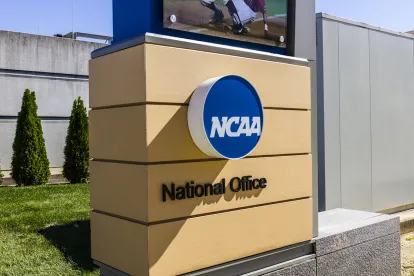Now that a regulatory framework is in place, either by way of the NCAA’s interim policy or through the various state laws discussed in the second iteration of this blog series, academic institutions and private entities, such as alumni and companies, have quickly engaged in the NIL space. This final post of our three-part blog series explores some of the ways these entities and individuals have interacted with NIL in the world of college athletics.
How Schools and Their Athletes Are Entering the Mix
Recognizing that NIL deals are now a significant factor in recruitment and that NIL is here to stay, schools are getting involved in the process. This is primarily accomplished in two ways: through school-specific NIL policies, and NIL departments aimed at facilitating and educating players.
School NIL Policies
Academic institutions are setting their own NIL policies to govern in addition to the NCAA’s interim policy and any applicable state law. These policies are primarily aimed at protecting a particular school’s intellectual property, e.g. trademarks, service marks, logos, or symbols. For instance, many institutional NIL rules prohibit players from appearing in photos or videos while wearing apparel bearing the school’s indicia. Where state laws do not do so, many school policies also prohibit players from engaging in NIL activity in particular industries, such as alcohol and tobacco.
NIL Departments and Partnerships
Many institutions have established NIL departments to help their players understand, navigate, and succeed in the new NIL landscape. The Ohio State University, for example, is at the forefront of this movement and has implemented what it refers to as an “Edge Team.” The goal of this team is to serve as “an internal advisory group whose members can assist student-athletes with access and resources to successfully pursue NIL opportunities. The Edge Team may work with companies and brands to assist in the NIL process, and it will also have the flexibility to monitor and adapt to changing guidelines and legislation.”
With virtually all of Ohio State’s varsity sports having designated staff to work on NIL requests, the university has also made it simple for companies to work with the players; a dedicated page on the OSU athletics website, titled NIL Simplified, allows for companies to fill out a form with their contact information and an indication of the player they would like to work with.
Schools have also instituted programs that, in addition to helping facilitate NIL deals, are designed to educate their student-athletes. To again use Ohio State as an example, the university has established a “Corporate Ambassador Program.” Through this program, Ohio State athletes serve as a corporate ambassador for a company within the community. In addition to “engag[ing] with the marketing department of each company to promote their brand,” student-athlete ambassadors will also be provided with career-building skills such as resume assistance, lessons on how to navigate corporate relationships, and an overall mechanism for them to gain marketing and advertisement experience. The purpose of the Corporate Ambassador Program, above all else, is to provide student-athletes with professional development to best prepare them for life after sport.
Rather than instituting internal NIL programs, other schools contract out such work to third-party entities to achieve similar goals, as outlined below.
How Companies and Private Individuals Are Entering the Mix
Experts predict that the NIL space is now a $100 million industry, with some athletes earning at least $1 million at the end of 20211. Companies and private individuals have also entered the mix. One such way in which the corporate world has entered the NIL space is through the creation of consulting firms. Another way is through the formation of NIL Collectives and Directives.
NIL Consulting Firms
Since Alston was decided, the NIL consultant industry has boomed and is predicted to continue to grow as more companies look to sign college athletes to NIL deals. In addition to facilitating activities, these consulting firms provide athletes with brand value assessments, live consultations, simplified ways for players to disclose their NIL activities to ensure compliance, as well as ways for players to maximize their social media presence.
Many of these firms partner with institutions and serve as the resource hub for student-athletes. NIL consultants primarily make their money when they match players to a particular deal, i.e. they receive a percentage of the deal’s total value.
NIL Collectives & Directives
Fans and alumni of various universities have taken it upon themselves to also assist student athletes in securing NIL opportunities through the formation of entities known as “NIL Collectives.”
NIL Collectives are entities formed to benefit specific schools, and are made up of fans and alumni. They generate NIL activities and funds for players by gathering funds from donors and businesses. Amongst other things, much of these activities include player participation in promotion for brand content, engagement in VIP events and experiences, autographed photos and personalized video messages, and special appearances on radio programs.
There are currently more than fifty NIL Collectives nationwide, with more being announced on a nearly weekly basis. For most NIL critics, Collectives are the crux of their concern. They argue that deals secured through Collectives straddle the line between lawful NIL recruiting deals and the prohibited pay-for-play model.
Additionally, there appears to be a new movement toward “NIL Directives,” which are similar to Collectives in that they are donor-driven and school-specific. Where they differ, however, is that “they are one-to-one financial transactions, typically between a wealthy booster or businessman and a specific college athlete from the school they support.” This form of facilitating NIL deals for players has also been the subject of scrutiny by NIL critics.
In an attempt to regulate these school-specific NIL Collectives/Directives, the NCAA amended its guidelines in May 2022, primarily to deal with booster involvement. In defining the term “booster,”2 the guidelines state that “[i]t appears that the overall mission of many, if not all, of [these] third party entities is to promote and support a specific NCAA institution by making available NIL opportunities to prospective student-athletes (PSA) and student-athletes (SAs) of a particular institution, thereby triggering the definition of a booster.”
The document goes on to provide guidance for dealing with booster-backed deals for both prospective and current student athletes. Notably, for prospective players, all recruiting conversations with individuals or entities that “[have] triggered booster status” are strictly prohibited.
The guidance for current players is far less restrictive and provides that agreements between players and boosters “may not be guaranteed or promised contingent on initial or continuing enrollment at a particular institution.” Though the question of how these guidelines will be effectively enforced is yet to be answered, the threat of losing everything they’ve worked for may be enough to compel student-athletes to comply.
Since the Alston ruling just over a year ago, the academic institutions, players, corporations, and private citizens that comprise the world of collegiate athletics have been navigating uncharted waters. The NIL space is lucrative, but because it is still in its infancy, those operating therein must tread carefully to ensure that they not only follow all academic rules, NCAA guidelines, and state laws, but also monitor the same as they continue to adapt and change to the new world of college athletics.
FOOTNOTES
[1] Some of the most lucrative NIL deals to date include the following: a football recruit is alleged to have signed a deal for $8,000,000; a football recruit signed a $1.4 million deal to sign autographs, and; a football player signed an $800,000 deal in exchange for certain brand promotion content. NIL is also not limited to collegiate football; for instance, and notably, a gymnast signed a promotion deal for a particular brand in excess of $1 million.
[2] The NCAA defines the term “booster” as: [A]n individual, independent agency, corporate entity (e.g., apparel or equipment manufacturer) or other organization who is known (or who should have been known) by a member of the institution’s executive or athletics administration to have participated in or to be a member of an agency or organization promoting the institution’s intercollegiate athletics program or to assist or to have assisted in providing benefits to enrolled student-athletes or their family members. Interim Name, Image and Likeness Policy Guidance Regarding Third Party Involvement, Nat’l Collegiate Athletic Ass’n, https://ncaaorg.s3.amazonaws.com/ncaa/NIL/May2022NIL_Guidance.pdf (last visited June 29, 2022).




 />i
/>i

